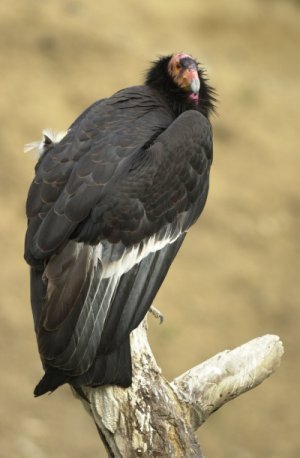Endangered Species Recovery Program | |
|
Home | News | Publications | Species profiles | Data and maps | About | Staff | Links | Department of Biological Sciences | CSU Stanislaus |

California condor
Gymnogyps californianus
STATUS
U.S.A. and California Endangered
LIFE HISTORY
The California condor is North America's largest land bird. Adult condors have a bare, orange or yellow-orange head and neck and a white bill. Both sexes of this species have similar coloration. The body is mostly black, but the feathers on the back are edged with brown. The underside of each wing has a white triangle-shaped patch that extends outward from the sides of the body and can readily be seen when the birds are soaring overhead. A whitish wing bar is found on the uppersurface of each wing. The legs are pink.
Immature condors have a dark head and neck that are covered with gray down. The underwing patch may vary from mottled white to nearly all black. The color of the head and neck turns orange and the underwing patches become white as immatures become adults at 5 to 6 years of age.
As with all birds in the vulture family, California condors lack strong talons for killing prey and feed strictly on carrion. It is impossible for them to carry anything with their feet and they carry very little in their beak. They have never been known to attack a living animal. Condors require approximately 0.91 kg (2 pounds) of food a day, but after gorging, they can quickly convert food into fat and can go for days without eating. They gorge themselves again when another carcass is found. Their keen sight is helpful in locating food.
Similar to turkey vultures ( Cathartes aura), condors require large areas of open savannah, grasslands, and foothill habitat with rock outcrops and large trees for nesting and roosting. They nest on a bare surface on the floor of a cave, in a cliff face, or on a steep slope; no nest is constructed. Condors may not breed every year; when they do only a single egg is laid, usually between February and May. The egg is incubated by both adults. Incubation lasts approximately 59 days. The chick is raised by both parents with the food being brought to the nest in the crop of the adult and regurgitated. The young condor remains in the nest for 5 to 7 months at which age it can make short flights. It remains dependent on the adults until it is 12 to 14 months old.
The population decline of the species began with the settlement of the west in the 1800's. Since then, direct and indirect human interference has plagued this species, leading almost to its extinction in the 1980's. In 1977, approximately 45 birds were known to exist in the wild, and by 1985 only 9 birds remained in the wild. On 19 April 1987 the last free-flying condor was captured from the wild and placed in captivity. At that time, only 27 condors were alive, all in zoos. Successful captive breeding programs at the San Diego and Los Angeles zoos led to the doubling of the number of condors by 1992. Two chicks born in captivity in 1992 were released into the wild in southern California. Since then, 31 condors have been released at 3 different sites in southern California. As of December 1996, 17 of the 31 condors remain in the wild; 5 have died--4 from collisions with powerlines and 1 from accidental ingestion of anti-freeze. Nine others were captured and brought into the captive breeding program because of their tendency to be attracted to human activities and structures.
Distribution
The condor once ranged over much of western North America from British Columbia to Baja California. Historically, California condors were essentially nonmigratory, but there tended to be a shift of the population to the southern portion of its range during the winter months. The current distribution is restricted to the mountain ranges surrounding the southern San Joaquin Valley, California. They nest at elevations between 610 and 1,983 meters (2,000-6,500 ft), but can be found at elevations between sea level and 2,745 meters (9,000 ft). In December 1996, nine captive-born individuals were released at the Vermillion Cliffs of the Grand Canyon National Park, Arizona.
CLASSIFICATION
Order FALCONIFORMES, Family CATHARTIDAE, Genus Gymnogyps, Species californianus
SUBSPECIES
None
RECENT SYNONYMS
None
OTHER COMMON NAMES
California vulture, condor
REFERENCES
Koford, C. B. 1950. The natural history of the California condor ( Gymnogyps californianus). Ph.D. disseration, Univ. California, Berkeley; Synder, N. F., and H. A. Snyder. 1989. Biology and conservation of the California condor. Current Ornithology 6:175-267; Mesta, R. 1996. Return to the wild: briefing packet. California Condor Recovery Program, U. S. Fish and Wildlife Service, Ventura, CA.
SIZE
Length:
109-140 cm (43-55 inches)
Wingspan:
259-290 cm (102-114 inches, 8.5-9.5 feet)
Weight:
8.2-14.1 kg (18-31 pounds)
IDENTIFICATION
Adult condors somewhat resemble turkey vultures in coloration, but the condor is twice as large. The immense size and white underwing patches of the adults are the most obvious field identification features.
AUTHOR OF PROFILE
N. L. Brown